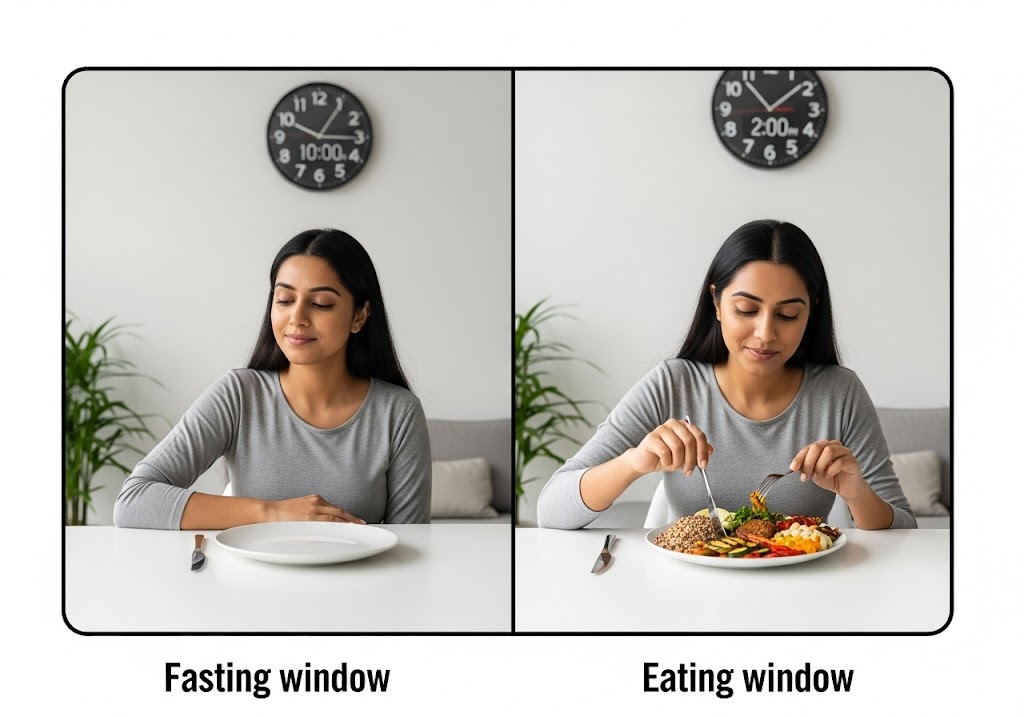An intermittent fasting plan is a structured eating schedule that alternates between eating and fasting periods to promote weight loss and health benefits.
Creating an effective intermittent fasting plan has become one of the most popular approaches to weight management and overall wellness. This eating pattern focuses on when you eat rather than what you eat, making it appealing to many people seeking sustainable lifestyle changes. An intermittent fasting plan can help regulate metabolism, improve insulin sensitivity, and support healthy weight loss goals.
Unlike traditional calorie-restriction diets, an intermittent fasting plan works by extending the natural fasting period that occurs during sleep. This approach triggers various metabolic processes that can lead to fat burning, cellular repair, and improved energy levels. Many people find that following an intermittent fasting plan simplifies their daily routine while providing significant health benefits.
Table of Contents
What is Intermittent Fasting?
Understanding what intermittent fasting means is essential before starting any intermittent fasting plan. Intermittent fasting is an eating pattern that cycles between periods of eating and fasting, focusing on when you eat rather than restricting specific foods. This approach has been practiced for centuries across various cultures and religions.
An intermittent fasting plan doesn’t dictate what foods you should eat, but rather when you should eat them. During fasting periods, you consume little to no calories, typically allowing water, tea, and black coffee. The eating windows vary depending on the specific intermittent fasting plan you choose, ranging from a few hours to entire days.
| Intermittent Fasting Plan Type | Eating Window | Fasting Period | Difficulty Level |
|---|---|---|---|
| 16/8 Method | 8 hours | 16 hours | Beginner |
| 18/6 Method | 6 hours | 18 hours | Intermediate |
| 20/4 Method | 4 hours | 20 hours | Advanced |
| 5:2 Method | 5 normal days | 2 restricted days | Intermediate |
| Eat-Stop-Eat | 6 days | 1-2 full days | Advanced |
| Alternate Day | Every other day | Every other day | Advanced |

How Does an Intermittent Fasting Plan Work?
The science behind how an intermittent fasting plan works involves several metabolic processes that occur during extended periods without food consumption. When you follow an intermittent fasting plan, your body undergoes significant changes in hormone levels, cellular function, and gene expression that promote weight loss and health improvements.
During the fasting periods of an intermittent fasting plan, insulin levels drop significantly, which facilitates fat burning. Growth hormone levels increase, sometimes by as much as 5 times normal levels, which aids in fat loss and muscle gain. Additionally, your body initiates cellular repair processes, including autophagy, where cells remove old and dysfunctional proteins.
The metabolic switch that occurs during an intermittent fasting plan typically happens after 12-16 hours of fasting. At this point, your body shifts from using glucose as its primary fuel source to burning stored fat for energy. This process, known as ketosis, is a key mechanism that makes an intermittent fasting plan effective for weight loss and metabolic health improvement.
Activate your glutes and hamstrings: how to do glute bridge for strength and posture

Popular Intermittent Fasting Plans
Choosing the right intermittent fasting plan depends on your lifestyle, health goals, and personal preferences. Each method offers different benefits and challenges, making it important to select an approach that you can maintain consistently for long-term success. The most popular intermittent fasting plan options provide flexibility while delivering proven results. Beginners often start with less restrictive methods before progressing to more advanced approaches. Understanding the different types helps you make an informed decision about which intermittent fasting plan suits your needs best.
16/8 Intermittent Fasting Plan
The 16/8 intermittent fasting plan is the most beginner-friendly and sustainable method for most people. This approach involves fasting for 16 hours and eating within an 8-hour window each day, making it easy to incorporate into daily routines without major lifestyle disruptions.
Start your fitness journey by learning how to start calisthenics as a perfect complement to your intermittent fasting plan.
What is 16/8 intermittent fasting? This method typically involves skipping breakfast and eating your first meal around noon, then finishing your last meal by 8 PM. The 16/8 intermittent fasting plan allows your body to enter a fasting state while you sleep and extends it through the morning hours when many people naturally have lower appetite levels.
18/6 Intermittent Fasting Plan
The 18/6 intermittent fasting plan extends the fasting period by two additional hours compared to the 16/8 method. This approach requires eating all meals within a 6-hour window while fasting for 18 hours, providing enhanced metabolic benefits for those ready for a more challenging approach.
This intermediate-level intermittent fasting plan often produces faster results due to the extended fasting period. However, it requires more discipline and careful meal planning to ensure adequate nutrition within the shorter eating window while maintaining energy levels throughout the day.
Other Intermittent Fasting Methods
Advanced practitioners seeking to customize their intermittent fasting plan can explore alternative methods beyond the standard daily approaches. These methods offer different scheduling patterns and intensity levels to match specific lifestyle needs and health goals.
| Method | Schedule | Eating Pattern | Calories | Best For |
|---|---|---|---|---|
| 5:2 Method | 5 normal + 2 restricted days | Normal eating 5 days, restrict 2 days | 500-600 on fasting days | Flexible schedules |
| Alternate Day Fasting | Every other day | Normal eating alternates with fasting | 0-500 on fasting days | Rapid weight loss |
| Eat-Stop-Eat | 1-2 times weekly | 24-hour complete fasts | 0 calories during fasts | Experienced fasters |
| Modified ADF | 3-4 days weekly | Partial fasting days | 25% normal calories | Gradual approach |
| Extended Fasting | 48-72+ hours | Occasional long fasts | Water/electrolytes only | Medical supervision |
What Can I Eat While Intermittent Fasting?
Food choices during eating windows significantly impact the success of your intermittent fasting plan. Selecting nutrient-dense, satisfying foods helps maintain energy levels, supports metabolic health, and reduces cravings during fasting periods for optimal results.
| Food Category | Best Options | Benefits | Timing |
|---|---|---|---|
| Lean Proteins | Chicken, fish, eggs, legumes, tofu | Muscle maintenance, satiety | Every meal |
| Healthy Fats | Avocado, nuts, olive oil, fatty fish | Sustained energy, hormone production | With meals |
| Complex Carbs | Quinoa, sweet potatoes, oats, brown rice | Steady glucose, fiber | Post-workout/morning |
| Vegetables | Leafy greens, broccoli, peppers, carrots | Vitamins, minerals, fiber | Every meal |
| Fruits | Berries, apples, citrus fruits | Antioxidants, natural sugars | Between meals |
| Beverages (Fasting) | Water, herbal tea, black coffee | Hydration, appetite suppression | During fasts |
| Fermented Foods | Greek yogurt, kefir, sauerkraut | Gut health, probiotics | With meals |
Build core strength effectively by comparing sit ups vs crunches exercises during your workout sessions.
Meal Plan and Getting Started
Creating a structured meal plan makes transitioning to an intermittent fasting plan much easier and more sustainable. Planning your meals ensures you get adequate nutrition within your eating window while avoiding impulsive food choices that might derail your progress. A typical meal plan for an intermittent fasting plan includes two to three well-balanced meals during your eating window. Focus on including lean proteins, healthy fats, complex carbohydrates, and plenty of vegetables in each meal to maintain satiety and provide essential nutrients your body needs.
Optimal foods for your intermittent fasting plan include:
- Lean Proteins – Chicken, fish, eggs, legumes, and lean beef to maintain muscle mass
- Healthy Fats – Avocados, nuts, seeds, olive oil, and fatty fish for sustained energy
- Complex Carbohydrates – Whole grains, sweet potatoes, and quinoa for steady glucose release
- Vegetables and Fruits – Nutrient-dense options that provide vitamins, minerals, and fiber
- Hydrating Beverages – Water, herbal teas, and black coffee during fasting periods
- Fermented Foods – Yogurt, kefir, and sauerkraut to support digestive health
Learn more about supporting your fitness goals with calisthenics at home no equipment while following your intermittent fasting plan.

Intermittent Fasting Benefits
The numerous benefits of following an intermittent fasting plan extend beyond simple weight loss to include improvements in metabolic health, brain function, and longevity. Research has shown that an intermittent fasting plan can trigger positive changes in various biological processes that promote overall wellness.
Weight management represents the most commonly sought benefit of an intermittent fasting plan. By creating natural caloric restriction and improving metabolic flexibility, this eating pattern can lead to sustainable fat loss while preserving lean muscle mass. Additionally, an intermittent fasting plan can improve insulin sensitivity, reduce inflammation, and support cardiovascular health.
Scientific studies demonstrate multiple health benefits from following an intermittent fasting plan:
- Weight Loss – Natural caloric reduction and enhanced fat burning mechanisms
- Improved Insulin Sensitivity – Better blood sugar control and reduced diabetes risk
- Enhanced Brain Function – Increased focus, mental clarity, and neuroprotective effects
- Cellular Repair – Autophagy processes that remove damaged cellular components
- Heart Health – Improved cholesterol levels, blood pressure, and cardiovascular markers
- Longevity – Potential life extension through various anti-aging mechanisms
- Reduced Inflammation – Lower levels of inflammatory markers throughout the body
- Better Sleep Quality – Improved circadian rhythm regulation and sleep patterns
Consider combining your intermittent fasting plan with does calisthenics build muscle training for optimal body composition results.
Is Intermittent Fasting Safe?
Safety considerations are important when starting any intermittent fasting plan, especially for individuals with underlying health conditions or specific dietary needs. While research shows that intermittent fasting is generally safe for healthy adults, certain populations should exercise caution or avoid this eating pattern entirely.
Most people can safely follow an intermittent fasting plan when implemented gradually and with proper attention to nutrition quality during eating windows. However, it’s essential to listen to your body and adjust your approach if you experience negative side effects or health concerns while following your intermittent fasting plan.
Are There Risks of Intermittent Fasting?
Understanding potential risks helps you make informed decisions about whether an intermittent fasting plan is appropriate for your individual circumstances. While most people tolerate intermittent fasting well, some may experience side effects, particularly during the initial adaptation period. Common initial side effects of starting an intermittent fasting plan include hunger, fatigue, headaches, and difficulty concentrating. These symptoms typically subside within a few days to weeks as your body adapts to the new eating pattern and becomes more efficient at using stored energy during fasting periods.
Individuals who should avoid or modify an intermittent fasting plan include:
- Pregnant or Breastfeeding Women – Increased nutritional needs require consistent food intake
- People with Eating Disorders – May trigger unhealthy relationships with food
- Diabetics on Medication – Risk of blood sugar fluctuations and medication interactions
- Children and Adolescents – Growing bodies require consistent nutrition for proper development
- People with Certain Medical Conditions – Heart problems, kidney disease, or other health issues
- Those Taking Specific Medications – Some medications require food for proper absorption
Prepare your body properly with warm up exercises for beginners before any physical activity during your intermittent fasting plan.
Other Tips for Intermittent Fasting
Maximizing success with your intermittent fasting plan requires practical strategies beyond timing restrictions. These evidence-based tips help minimize side effects, maintain consistency, and optimize metabolic benefits while adapting to your chosen intermittent fasting plan approach.
Implementing these additional strategies enhances your intermittent fasting plan success:
- Stay Properly Hydrated – Drink plenty of water, herbal teas, and black coffee during fasting periods to manage hunger and support detoxification
- Maintain Electrolyte Balance – Add a pinch of sea salt to water or consume electrolyte supplements during extended fasting periods
- Plan Social Situations – Schedule meals during eating windows or focus on social connections rather than food consumption
- Listen to Your Body – Adjust fasting windows if you experience persistent fatigue, dizziness, or other concerning symptoms
- Quality Sleep is Essential – Aim for 7-9 hours nightly as poor sleep can disrupt hunger hormones and intermittent fasting plan effectiveness
- Manage Stress Levels – Practice meditation, yoga, or other stress-reduction techniques to prevent cortisol from interfering with results
- Start Gradually – Begin with shorter fasting periods and progressively extend them as your body adapts to the new eating pattern
- Track Your Progress – Monitor energy levels, weight changes, and overall well-being to fine-tune your intermittent fasting plan approach
Incorporate simple cardio exercises like how to do jumping jacks to boost energy levels during your eating windows.

10 Methods of Intermittent Fasting
Exploring the various methods available helps you find the perfect intermittent fasting plan that matches your lifestyle, preferences, and health goals. Each approach offers unique benefits and challenges, allowing you to customize your fasting experience based on your individual needs and circumstances.
Understanding the 10 ways to do intermittent fasting provides options for different experience levels and life situations. Some methods work better for beginners, while others suit experienced practitioners looking for more advanced approaches to enhance their results.
Supplement your intermittent fasting plan with how to start calisthenics for a complete wellness approach.
| Method | Fasting Period | Eating Window | Best For | Difficulty |
|---|---|---|---|---|
| 12:12 | 12 hours | 12 hours | Complete beginners | Very Easy |
| 14:10 | 14 hours | 10 hours | New practitioners | Easy |
| 16:8 | 16 hours | 8 hours | Most people | Moderate |
| 18:6 | 18 hours | 6 hours | Experienced users | Moderate-Hard |
| 20:4 | 20 hours | 4 hours | Advanced practitioners | Hard |
| OMAD | 23 hours | 1 hour | Experienced fasters | Very Hard |
| 5:2 | 5 normal days | 2 restricted days | Flexible schedules | Moderate |
| ADF | Alternating | Alternating | Weight loss focused | Hard |
| Eat-Stop-Eat | 24-hour fasts | 1-2 times weekly | Experienced | Hard |
| Extended | 48+ hours | Varies | Medical supervision | Expert |
1. 12:12 Method
The 12:12 intermittent fasting plan serves as the perfect introduction for complete beginners seeking a gentle entry into time-restricted eating. This method involves fasting for 12 hours and eating within a 12-hour window, typically aligning with natural sleep patterns for easy implementation and sustainability.
2. 14:10 Method
The 14:10 intermittent fasting plan extends the fasting period slightly while maintaining a comfortable eating window for new practitioners. This approach builds confidence and metabolic adaptation before progressing to more restrictive methods, making it ideal for those transitioning from the 12:12 method.
3. 16:8 Method
The 16:8 intermittent fasting plan represents the most popular and researched approach to time-restricted eating worldwide. This method balances effectiveness with sustainability, allowing most people to achieve significant health benefits while maintaining social flexibility and long-term adherence to their eating schedule.
4. 18:6 Method
The 18:6 intermittent fasting plan challenges experienced practitioners with an extended fasting window that enhances metabolic benefits. This method requires careful meal planning and strong commitment but often produces accelerated results for those ready to advance beyond the standard 16:8 approach.
5. 20:4 Method (Warrior Diet)
The 20:4 intermittent fasting plan, also known as the Warrior Diet, restricts eating to just four hours daily while fasting for twenty hours. This advanced approach requires significant experience and discipline but can provide impressive metabolic benefits for dedicated practitioners who have mastered shorter fasting periods.
Enhance your exercise routine by exploring different techniques like arnold press vs dumbbell press variations to maximize muscle development.
6. OMAD (One Meal A Day)
The OMAD intermittent fasting plan represents one of the most extreme daily fasting approaches, involving eating just one meal within a one-hour window. This method requires extensive fasting experience and careful attention to nutrient density to ensure adequate nutrition while maintaining health and energy levels.
Learn effective strength training techniques such as how to do arnold press to build muscle during your eating windows.
7. 5:2 Method
The 5:2 intermittent fasting plan offers flexibility by allowing normal eating five days weekly while restricting calories to 500-600 on two non-consecutive days. This approach suits people with variable schedules who prefer weekly rather than daily fasting patterns while still achieving metabolic benefits.
Consider complementing your routine with calories burned in lunges to maximize your fitness results during eating windows.
8. Alternate Day Fasting (ADF)
Alternate Day Fasting creates an intermittent fasting plan that alternates between normal eating days and very low-calorie or complete fasting days. This method can produce rapid weight loss results but requires strong commitment and careful monitoring to ensure nutritional adequacy and prevent excessive restriction.
9. Eat-Stop-Eat Method
The Eat-Stop-Eat intermittent fasting plan incorporates one or two complete 24-hour fasts per week into an otherwise normal eating schedule. This method allows flexibility in choosing fasting days while providing the benefits of extended fasting periods for experienced practitioners seeking periodic deeper fasts.
10. Extended Fasting
Extended fasting involves creating an intermittent fasting plan with fasting periods lasting 48-72 hours or longer for therapeutic purposes. This advanced method should only be attempted under medical supervision and requires extensive fasting experience, proper preparation, and careful monitoring of health markers throughout the process.
For those combining strength training with their intermittent fasting plan, learn how to lift heavier weights safely and effectively during eating windows.

Getting Started with Your Intermittent Fasting Plan
Successfully launching your intermittent fasting plan requires systematic preparation and realistic goal setting. Proper planning during the initial weeks establishes sustainable habits, minimizes adjustment difficulties, and creates the foundation for long-term success with your chosen intermittent fasting plan approach.
Consider enhancing your routine with warm up exercises for beginners before starting any workout during your intermittent fasting plan.
| Week | Focus Area | Action Steps | Expected Changes |
|---|---|---|---|
| Week 1 | Preparation | Choose method, clear schedule, stock healthy foods | Hunger adjustment, routine establishment |
| Week 2 | Adaptation | Maintain consistency, track symptoms, adjust timing | Reduced hunger pangs, energy stabilization |
| Week 3 | Optimization | Fine-tune eating windows, evaluate progress | Improved sleep, mental clarity |
| Week 4 | Establishment | Assess results, make permanent adjustments | Weight changes, metabolic improvements |
| Month 2-3 | Mastery | Advanced techniques, troubleshoot challenges | Significant body composition changes |
| Long-term | Maintenance | Lifestyle integration, periodic method switching | Sustained health benefits, habit formation |
Beginning your intermittent fasting plan successfully requires gradual implementation and realistic expectations. Most experts recommend starting with a gentler approach and progressively extending fasting periods as your body adapts to the new eating schedule. This method reduces potential side effects and improves long-term adherence to your chosen intermittent fasting plan.
Planning your first week carefully sets the foundation for long-term success with your intermittent fasting plan. Choose a start date when you have fewer social commitments and can focus on establishing new routines. Prepare your kitchen with healthy foods and remove tempting processed snacks that might derail your progress during the adjustment period.
Incorporate physical activity to enhance your results with does reformer pilates burn calories sessions during your eating windows.
Track your progress, energy levels, and any side effects during the first few weeks of your intermittent fasting plan. This information helps you make necessary adjustments and determine whether your chosen method works well for your lifestyle and goals. Remember that finding the right intermittent fasting plan may require some experimentation and patience.
Maximize calorie burning potential by learning how to burn 500 calories a day through various activities that complement your intermittent fasting plan.

Troubleshooting Your Intermittent Fasting Plan
Common challenges may arise when following an intermittent fasting plan, but most can be addressed with simple adjustments to your approach. Social situations, work schedules, and family commitments sometimes make it difficult to maintain consistent fasting windows, requiring flexibility and creative problem-solving strategies.
If you experience persistent hunger, fatigue, or other concerning symptoms while following your intermittent fasting plan, consider modifying your approach rather than abandoning it entirely. Shortening fasting periods, adjusting meal timing, or focusing more on food quality during eating windows often resolves most issues people encounter.
Enhance core strength during your eating windows with targeted calisthenics ab workout routines that support your fitness goals.
Managing social eating situations becomes easier with practice and planning when following an intermittent fasting plan. Communicate your eating schedule with friends and family, suggest restaurant meetups during your eating window, or focus on the social aspect rather than food when necessary. Flexibility prevents your intermittent fasting plan from becoming a source of stress or social isolation.
For effective upper body training, explore the differences between arnold press vs shoulder press techniques during your workout sessions.
Conclusion
An effective intermittent fasting plan offers a flexible, sustainable approach to improving health and achieving weight management goals. Success with any intermittent fasting plan depends on choosing the right method for your lifestyle, implementing changes gradually, and maintaining consistency over time. With proper planning and realistic expectations, an intermittent fasting plan can become a valuable tool for long-term wellness and vitality while supporting your overall health journey.
Want to master the calisthenics handstand and take your skills to the next level? Whether you’re a beginner or pushing advanced skills, ISC – Indian School of Calisthenics offers expert guidance to help you master bodyweight training. Visit us at SRPF Ground, NH8, Goregaon (E), Mumbai – 400065. For class schedules, personalized coaching, or more details, call +91 77159 53218. Train smart, move better, and unlock your back strength with ISC.
Intermittent Fasting Plan – FAQs
What is the best intermittent fasting plan for beginners?
The 16/8 method is ideal for beginners, involving 16 hours of fasting and 8 hours of eating daily.
How quickly will I see results from an intermittent fasting plan?
Most people notice initial changes within 2-4 weeks, with significant results appearing after 8-12 weeks of consistency.
Can I drink coffee during my intermittent fasting plan?
Yes, black coffee without sugar or cream is allowed during fasting periods and may enhance fat burning.
What should I eat when breaking my intermittent fasting plan?
Start with easily digestible foods like fruits, vegetables, or lean proteins rather than heavy or processed meals.
Is it safe to exercise while following an intermittent fasting plan?
Yes, light to moderate exercise is safe and beneficial, but avoid intense workouts during extended fasting periods.
Can I modify my intermittent fasting plan for weekends?
Flexibility is important for long-term success, so adjusting your schedule for social events is perfectly acceptable.
How much weight can I lose with an intermittent fasting plan?
Weight loss varies individually, but many people lose 0.5-1 kg per week when combined with healthy eating.
Should I take supplements during my intermittent fasting plan?
Basic vitamins and minerals are fine, but avoid supplements with calories or artificial sweeteners during fasting.
Can I do intermittent fasting plan if I have diabetes?
Consult your doctor first, as medication adjustments may be necessary to prevent blood sugar complications.
What happens if I break my intermittent fasting plan occasionally?
Occasional breaks won’t ruin your progress; simply return to your schedule the next day without guilt or restriction.


